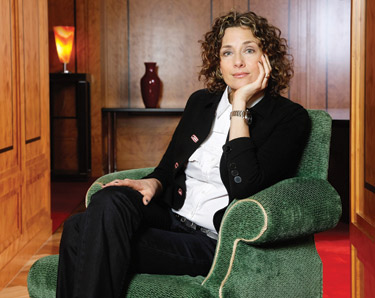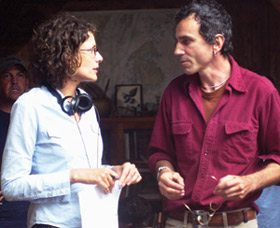BY JAMES ULMER
 DREAMY: For her latest film, The Private Lives of Pippa Lee, Miller
DREAMY: For her latest film, The Private Lives of Pippa Lee, Miller
wanted to create an impressionistic story that still "punches you
in the gut." (Credit: Florian Seefried/Getty Images)Rebecca Miller seems comfortable shuffling between worlds. A Connecticut native who now calls Ireland home, she was a painter and actress before turning to writing and directing. She's the child of two renowned artists—playwright Arthur Miller and photographer Inge Morath—who managed to escape her parents' long shadows by finding her own artistic voice in short stories, a novel and four movies. As a filmmaker, she's traveled to parts of her own turbulent past, but none of her creations seem as close to home as her most recent feature, The Private Lives of Pippa Lee.
"In a funny way, this film has more of myself than any other I've done," Miller noted in Berlin, before the premiere of her movie at the Berlin International Film Festival. "I don't mean literally autobiographical, I mean in the way that comedy coexists with the sadness, and the way the past inhabits the present."
That kind of shape-shifting will be familiar to viewers of Miller's last two features—the Sundance Grand Jury Prize winner Personal Velocity, adapted from her short story collection, and The Ballad of Jack and Rose, starring her husband Daniel Day-Lewis. Like Pippa, these films showcase Miller's strengths as a director: a painterly attention to light and color and her ability to reflect her characters' inner lives through the style of shooting. "Everything on the set is built around the actors and their characters' psychology," she said.
For example, in the 2005 drama The Ballad of Jack and Rose, the story of an embittered '60s idealist and his teenage daughter, Miller and crew built the sets to allow actors to follow the camera from room to room, and shot scenes in sequence. As one scene finished shooting, a cameraman would reload a second camera, scuttle down a hall and position himself to shoot the next scene. "It was really like theater and an athletic event combined," said Miller.
Her commitment to match stagecraft with content is also evident in the three portraits of emotionally scarred women that make up Personal Velocity. One of the characters (played by Fairuza Balk) copes with a failed relationship and unwanted pregnancy, experiencing the world, as Miller put it, "in little macro-epiphanies of super close-ups" that prevent her from seeing life's bigger picture. To capture that state, Miller shot the segment with handheld cameras and in claustrophobic close-ups that effectively push the viewer into the woman's subjective and disoriented point of view.
Miller made her first foray into directing with the short film Florence in 1990, but kept her urge to write and direct features a secret until she had finished her first full-length screenplay, Angela, a lyrical drama she directed in 1995 that won the Filmmaker's Trophy at Sundance.
"I was the only one who really knew I wanted to direct films," she mused. "People were surprised I went in that direction, but as an actress I'd learned from some of the best directors in the business. It was like going to film school."
Pippa Lee is based on Miller's first novel, which was published in 2008. Unlike the book's more straightforward narrative, the movie plays out as a kind of dreamlike dialogue between the past and present, wending in and out of multiple time periods, tones and characters. Scenes flow back and forth between Pippa's memories of her often violent past with her drug-addled mother, her rocky relationships in New York in the freewheeling '70s, and her present life as a devoted mother and housewife in a staid Connecticut retirement home.
"I wanted this film to move in the liquid way that thought and emotion moves, in an impressionistic way," Miller explained. "The challenge was to keep it rooted in a very real and identifiable story that punches you in the gut."
Miller also knew she would need to shoot Pippa differently than she'd shot her other films. The use of handheld cameras, so pervasive in her past work, would be "too intrusive" for a story that moves so fluidly through time. Instead, the camera in Pippa Lee moves constantly but very precisely within controlled shots, allowing the viewer, as Miller describes it, to "step back and let the story unfold."
But her biggest challenge was finding an integrated visual language to help bridge the scenes of Pippa's past memories with the present day. To tackle it, Miller screened several movies for her cinematographer, Declan Quinn (Rachel Getting Married), and her production designer, Michael Shaw (Boys Don't Cry), including High Society and the British Technicolor film Black Narcissus. Using color details of the former and the more stark colors of the latter, they found the palette for the film's lighting, wardrobe and set design. "For me, color creates emotion, even in the most subtle ways," she offered.
 FAMILY AFFAIR: Miller directs her husband, Daniel Day-Lewis,
FAMILY AFFAIR: Miller directs her husband, Daniel Day-Lewis,
as an embittered idealist trying to raise his daughter in The
Ballad of Jack and Rose. (Credit: IFC Films/Everett)So for Pippa's troubled childhood during the '60s, pastel pinks pop up frequently—on a bedspread, or in her mother's robe—to provide a feeling of nostalgia and reassurance even for an often-violent past. In the '70s, when Pippa's life with her mother is falling apart, the set and costumes are suffused with brown. Violent reds pop up on a church door here or a lawn ornament there, as if to signal the detonation of memory landmines to come.
To illuminate Pippa's lives, Quinn worked without a grid and placed his lights far out past the set, bouncing the light back to the camera. "In this way he created a world that just glows," Miller remarked. "There's this almost diaphanous wash of color throughout the film because he uses gels in a very subtle way."
Equally critical to the film's flow are its carefully crafted visual transitions between Pippa's past and the present. Shooting on a tight budget in a Connecticut warehouse, the strategy required careful planning, using scale models to work out the camera movements. "I knew that these concrete transitions were integral to the look and feel of the film," she explained. "But I didn't want to do them in post, partly because we didn't have much money, and partly because it felt more intuitive and organic to do it in camera."
In one such transition, Pippa sits in a restaurant with her family, gazing at her daughter as a waiter delivers a cake to their table. As she lapses into a reverie, the camera, in a single take, follows the cake as the waiter carries it past the restaurant table and delivers it to another table in another time period entirely; suddenly, we're at the kitchen table of Pippa's childhood, where she and her mother are now sitting as the waiter sets the cake down. It's a seamless visual stitching which Miller created by cutting out a piece of the film's period kitchen set and "grafting" it onto the present-day restaurant set next to it.
"I want it to seem like you're looking at a painting with many panels, and the panels reflect each other," said Miller, who studied art and painting at Yale. "The idea is you're watching a scene one minute and then suddenly thinking—how did I get here? By the time you've realized that, you're already involved in the next scene, kind of like catching yourself in a daydream."
One of Miller's favorite scenes finds the adult Pippa (Robin Wright Penn) sitting in a truck with her neighbor Chris (Keanu Reeves) just talking about her daughter. "It's the moment when you're falling in love with somebody," said Miller, "when something in the air is quickening." To capture this feeling the director used a bungee-mounted camera to give the scene a feeling of freedom and elasticity. "It's a very subtle effect, almost like the camera is breathing, and it loosens up the performances so that the characters feel even more present to each other."
It is this kind of precise work with her ensemble cast—Alan Arkin, Maria Bello, Julianne Moore and Winona Ryder—that effectively unifies the movie's varying tones and story lines. "All actors have metal filings in them, and the director is like a magnet," she observed. "You have to make sure all the filings line up in the same direction, so that everybody is making the same film."
Miller prefers to have few or no rehearsals in order to capture "the most real and immediate moments as they happen before the camera," and she refrains from too much discussion on a set. "I don't think I really had the gift for acting," she laughed. "But whatever talent I did have was pretty much squelched by directors talking too much."
In a strange way, Miller sometimes noticed aspects of Pippa's lives bleeding into her own life on the set. "As a director, I found myself, like her, constantly having to flip back and forth between two different modalities," she explains, "from being outside the story looking over its shoulder as a writer and director, to jumping back inside of it, helping the actors with their needs and completely living the story itself."
She smiles, as if visiting a brief daydream. "When you're on the inside of that world, the problems of Rebecca don't matter at all. It's the opposite of self-consciousness—it's self-unselfconsciousness, a kind of transparency. To migrate between these two worlds as a director, that's a very special way of living. It's another kind of flow."